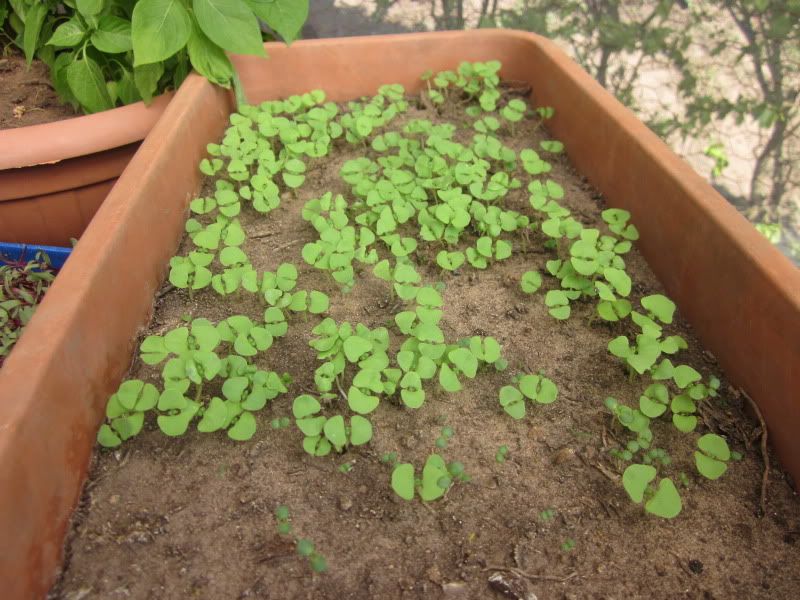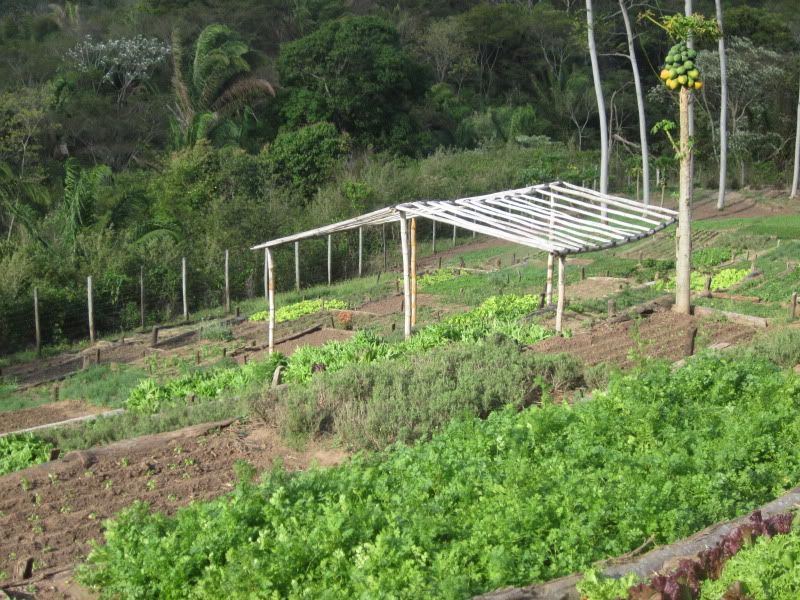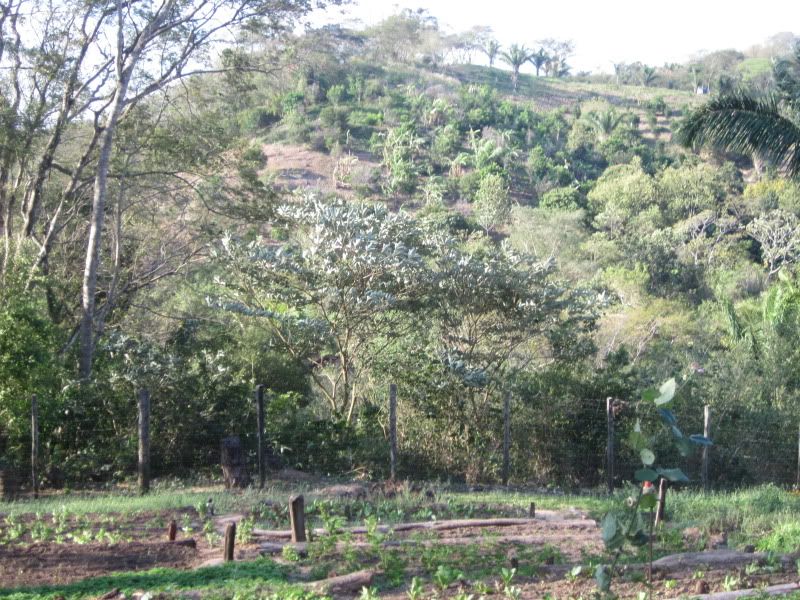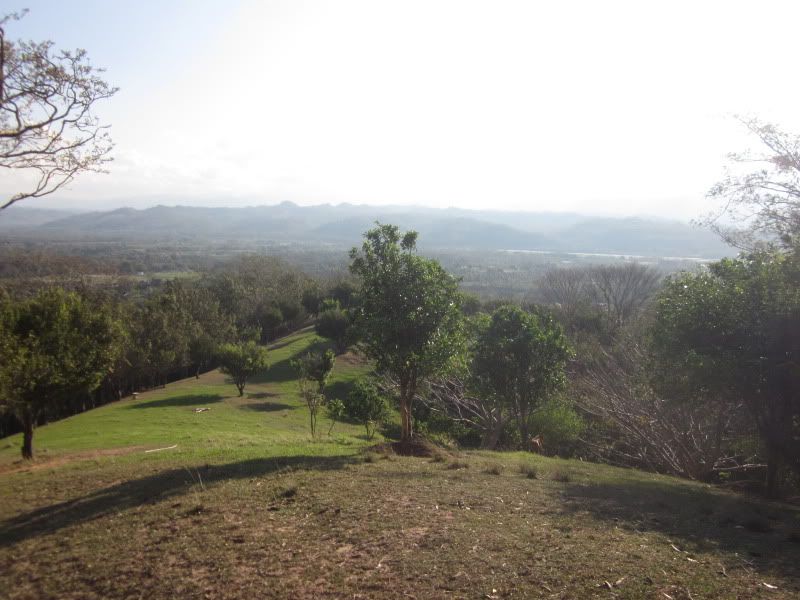This diary covers the organic farm we visited on our first day with PROBIOMA.
To say we were shocked when we arrived at Casa Loma is an understatement. If you've followed these diaries, you're aware of the poverty we'd seen throughout the trip. Next thing you know, we pull up at a "small farm" that looks like this:

Casa Loma, the house
The couple who owned the home and the "small farm" (which is more of a very large market garden) was lovely. They spoke English fluently. The man was educated at Texas A & M and he was working in the Chaco in the oil industry when they met. The woman was in the Chaco because her father had a cattle ranch there. Since they've been married, they've lived all over the world, in several countries, and their children are now spread out around the world as well.
The couple has lived here now for 10 years. One of their children actually designed this home for them. They named it Casa Loma (Hill House), which is also the name of the brand they sell their produce under. They have a total of 11 hectares, but a relatively small part of that is used for growing food. The land is worked by 8 employees, four full time and four half time. The couple who owns the place spent several months in the U.S. this past year, so clearly production can continue easily without them.
The woman led us around her property and her gardens, beginning with a tour of a small greenhouse, where she had a number of seedling trays for cut baby greens and perhaps for starts to transplant into the garden as well although I'm not sure about that.

The greenhouse

Seedling trays

Beet seedlings

Lettuce seedlings
From there, we walked down a path through a patch of forest to get to the garden. During our walk, I recognized a motacu palm, the most important palm in Bolivia's Amazon region where I visited in 2010. I guess it grows here too. The woman also pointed out a vanilla vine:

A motacu palm

Vanilla
Then we arrived at the gardens:





A view of the terraces
As you can see, it was arranged like a patchwork quilts, with beds that were each maybe four feet wide and perhaps ten feet across, each filled with a different crop. These beds were on terraces, and some were under a roof for plants that cannot tolerate the rainy season. Within each bed, the plants were planted along ridged rows in straight lines.
The plants were planted in the low part of the ridges, where they would be covered in water during heavy rains or when irrigated. Even here, the climate crisis is changing the rains. Usually the rainy season begins in November, she said, but the last 3-4 years it began late, in December.
Casa Loma grows a lot of high value crops like leafy greens and herbs, as well as peppers, tomatoes, and onions. During our visit, we saw: onions, spinach, peppers, lettuce, arugula, carrots, spinach, beets, radish, tomatoes. They also have wild passion fruit growing here, including a local variety called pachío.

Spinach

Tomatoes

Lettuce

Sweet peppers

Radishes
They also grows several types of sprouts: Broccoli, radish, alfalfa, and one more.

Tanya with some sprouting trays
We also saw the following herbs: chives, thyme, oregano, rosemary, dill, garlic chives, parsley, cilantro, basil, mint, marjoram.

A marigold with chives

Mint

Oregano
For fertility, they add composted chicken bedding to the soil. They get it from the many chicken farms in the area, and then mix it with dirt and debris from the forest to compost it before adding it to the soil.

Composted chicken bedding
She brings many of her seeds from the U.S. but sometimes she allows her plants to go to seed and then saves the seeds.

Lettuce that is going to seed.

Arugula going to seed.
The carrots below are too old to sell. When this happens the workers take them home or they are given to a nearby orphanage.

Irrigation and carrots
During our visit, I asked why they were committed to organic. The woman told us she grew up on a ranch in the south of Bolivia and her parents did not use any chemicals. Her grandfather was German and he taught her father how to grow food organically. She went to school in Argentina but then she and her siblings would return to the ranch on their vacation and would help in the gardens. She said that back then, Bolivia just didn't have diseases so there were no reasons to spray. But then industrial cotton production came to Bolivia, and with it came spraying. That's when plant diseases first became an issue.
Her travel around the world increased her awareness of organic, and when she and her family are in the U.S. they buy organic. She has two grandchildren in the U.S. and their mother buys organic food for them.
As a form of pest control, they bring a bunch of baby chicks into the garden during the rainy season every year. The rainy season brings grasshoppers, and the chicks eat them up. But you cannot leave the chickens in the garden forever or else they will eat all of the plants too. The larger chickens are kept elsewhere for both meat and eggs, although she says it makes her sad to kill them. She doesn't kill them herself though - the workers do.
Another pest they have a problem with is one they call an "abuela" (grandmother) bug. They are trying to use PROBIOMA's biological controls on the abuelas but they've also had luck using dish detergent and sunflower oil. (I'd caution anyone who wanted to try that at home. Soap is fine if it works; detergent takes longer to break down in the environment and is possibly contaminated with a carcinogen.) The detergent and oil worked so well she had a hard time finding a live bug to even show us.

An abuela bug

Another abuela

Peppers that were eaten by abuelas
We walked back toward the house with her to see where the greens are packaged. As we walked, we saw a banana tree. This area was all forested when they bought it, and they had it all cleared by hand - not burned - by their workers. The road to their home was also built entirely with manual labor.

Banana tree that is planted right where the greywater from washing the vegetables flows.

Some of the forest that remains on the property.
As we walked, she pointed out a "Palo Borracho" (Drunken Branch) tree, which is also called the Silk Floss tree or Ceiba speciosa. She said you can stuff pillows with the "cotton" but it is so humid in Santa Cruz that you need to put them in the sun every day to dry them out and fluff them back up.

A Palo Borracho tree

The "cotton" from the palo borracho
Here are the greens, being packaged and going to market. They sell the packages for 8 Bolivianos each (a little more than US$1), and the store then sells them for 12 Bolivianos apiece.

The greens, all packaged for the store. Notice that they ARE being advertised as "organic."

Packaged greens

Packaged greens

Greens going to market
A few days later, we went to the grocery store where Casa Loma brand is sold to compare their prices against other products.
It was difficult to compare because everything was packaged and it was hard to account for the weight of the packaging when weighing each product, but it was obvious that Casa Loma's products are expensive. For example, a package of Casa Loma spinach sells for 10.39 Bolivianos. Non-Casa Loma spinach sells for 2 Bolivianos for a bag.
Casa Loma's arugula sells for 11.90 Bolivianos, and the entire package (including the weight of the container) was a mere 0.078 kg. A larger container from Casa Loma packed with mizuna also sells for 11.90 Bolivianos. Same with their romaine and mesclun. Casa Loma alfalfa sprouts were sold for 11.30 Bolivianos. Casa Loma parsley went for 10.60 Bolivianos.
Of the non-Casa Loma products available, a bag of what looked like butter lettuce sold for 6.30 Bolivianos. Parsley went for 6 Bolivianos per kilo, and a bag weighs much less than a kilo.
After our stop near the house where the greens were being packaged, we visited the orchard, where they grow macadamia nuts, bananas, lemons, avocados, different types of mangoes, tangerines, mandarins, oranges, tamarind, and papayas.

The orchard

Papayas... the monkeys like to come take these.
I don't have a photo of it but they also keep 10 beehives and produce their own honey.

Peggy with their dog.
Our last stop was inside their home (which was GORGEOUS), where they showed us the salad dressings they make and market too. They let us try them with some of their vegetables. Delicious, of course.

As we were leaving, the woman's husband asked me what I thought of Rick Perry for President. So there you go, that's Santa Cruz for you. It's another planet from everywhere else in Bolivia I've been.
No comments:
Post a Comment